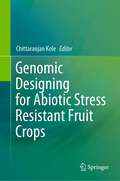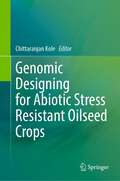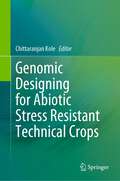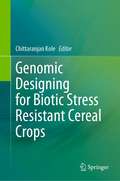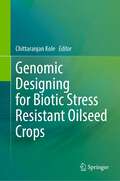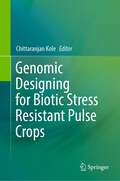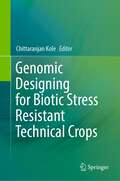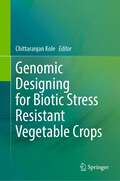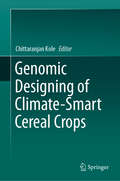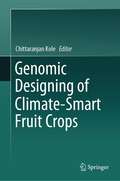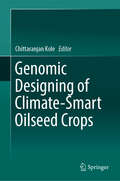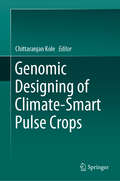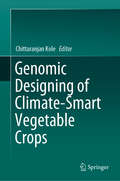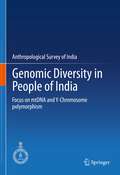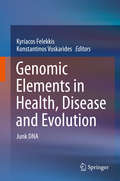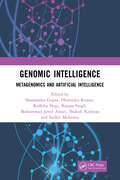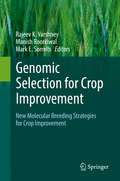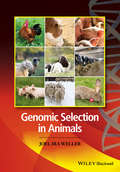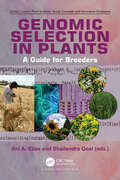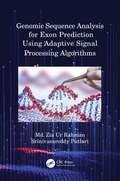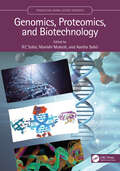- Table View
- List View
Genomic Designing for Abiotic Stress Resistant Fruit Crops
by Chittaranjan KoleThis book presents deliberations on molecular and genomic mechanisms underlying the interactions of crop plants to the abiotic stresses caused by heat, cold, drought, flooding, submergence, salinity, acidity, etc., important to develop resistant crop varieties. Knowledge on the advanced genetic and genomic crop improvement strategies including molecular breeding, transgenics, genomic-assisted breeding, and the recently emerging genome editing for developing resistant varieties in fruit crops is imperative for addressing FHNEE (food, health, nutrition, energy, and environment) security. Whole genome sequencing in many of these crops followed by genotyping-by-sequencing has provided precise information regarding the genes conferring resistance useful for gene discovery, allele mining, and shuttle breeding which in turn opened up the scope for 'designing' crop genomes with resistance to abiotic stresses. The seven chapters each dedicated to a fruit crop and a fruit crop group in this volume elucidate different types of abiotic stresses and their effects on and interaction with the crops; enumerate the available genetic diversity with regard to abiotic stress resistance among available cultivars; illuminate the potential gene pools for utilization in interspecific gene transfer; present brief on classical genetics of stress resistance and traditional breeding for transferring them to their cultivated counterparts; depict the success stories of genetic engineering for developing abiotic stress-resistant crop varieties; discuss on molecular mapping of genes and QTLs underlying stress resistance and their marker-assisted introgression into elite varieties; enunciate different genomics-aided techniques including genomic selection, allele mining, gene discovery, and gene pyramiding for developing adaptive crop varieties with higher quantity and quality of yields, and also elaborate some case studies on genome editing focusing on specific genes for generating abiotic stress-resistant crops.
Genomic Designing for Abiotic Stress Resistant Oilseed Crops
by Chittaranjan KoleThis book presents deliberations on molecular and genomic mechanisms underlying the interactions of crop plants to the abiotic stresses caused by heat, cold, drought, flooding, submergence, salinity, acidity, etc., important to develop resistant crop varieties. Knowledge on the advanced genetic and genomic crop improvement strategies including molecular breeding, transgenics, genomic-assisted breeding, and the recently emerging genome editing for developing resistant varieties in oilseed crops is imperative for addressing FHNEE (food, health, nutrition, energy, and environment) security. Whole genome sequencing of these crops followed by genotyping-by-sequencing has provided precise information regarding the genes conferring resistance useful for gene discovery, allele mining, and shuttle breeding which in turn opened up the scope for 'designing' crop genomes with resistance to abiotic stresses. The eight chapters each dedicated to a oilseed crop in this volume elucidate on different types of abiotic stresses and their effects on and interaction with the crop; enumerate on the available genetic diversity with regard to abiotic stress resistance among available cultivars; illuminate on the potential gene pools for utilization in interspecific gene transfer; present brief on classical genetics of stress resistance and traditional breeding for transferring them to their cultivated counterparts; depict the success stories of genetic engineering for developing abiotic stress-resistant crop varieties; discuss on molecular mapping of genes and QTLs underlying stress resistance and their marker-assisted introgression into elite varieties; enunciate on different genomics-aided techniques including genomic selection, allele mining, gene discovery, and gene pyramiding for developing adaptive crop varieties with higher quantity and quality of yields, and also elaborate some case studies on genome editing focusing on specific genes for generating abiotic stress-resistant crops.
Genomic Designing for Abiotic Stress Resistant Pulse Crops
by Chittaranjan KoleThis book presents deliberations on molecular and genomic mechanisms underlying the interactions of crop plants to the abiotic stresses caused by heat, cold, drought, flooding, submergence, salinity, acidity, etc., important to develop resistant crop varieties. Knowledge on the advanced genetic and genomic crop improvement strategies including molecular breeding, transgenics, genomic-assisted breeding, and the recently emerging genome editing for developing resistant varieties in pulse crops is imperative for addressing FHNEE (food, health, nutrition, energy, and environment) security. Whole genome sequencing of these crops followed by genotyping-by-sequencing has provided precise information regarding the genes conferring resistance useful for gene discovery, allele mining, and shuttle breeding which in turn opened up the scope for 'designing' crop genomes with resistance to abiotic stresses. The nine chapters each dedicated to a pulse crop in this volume elucidate on different types of abiotic stresses and their effects on and interaction with the crop; enumerate on the available genetic diversity with regard to abiotic stress resistance among available cultivars; illuminate on the potential gene pools for utilization in interspecific gene transfer; present brief on classical genetics of stress resistance and traditional breeding for transferring them to their cultivated counterparts; depict the success stories of genetic engineering for developing abiotic stress-resistant crop varieties; discuss on molecular mapping of genes and QTLs underlying stress resistance and their marker-assisted introgression into elite varieties; enunciate on different genomics-aided techniques including genomic selection, allele mining, gene discovery, and gene pyramiding for developing adaptive crop varieties with higher quantity and quality of yields, and also elaborate some case studies on genome editing focusing on specific genes for generating abiotic stress-resistant crops.
Genomic Designing for Abiotic Stress Resistant Technical Crops
by Chittaranjan KoleThis book presents deliberations on molecular and genomic mechanisms underlying the interactions of crop plants to the abiotic stresses caused by heat, cold, drought, flooding, submergence, salinity, acidity, etc., important to develop resistant crop varieties. Knowledge on the advanced genetic and genomic crop improvement strategies including molecular breeding, transgenics, genomic-assisted breeding, and the recently emerging genome editing for developing resistant varieties in technical crops is imperative for addressing FHNEE (food, health, nutrition, energy, and environment) security. Whole genome sequencing in many of these crops followed by genotyping-by-sequencing has provided precise information regarding the genes conferring resistance useful for gene discovery, allele mining, and shuttle breeding which in turn opened up the scope for 'designing' crop genomes with resistance to abiotic stresses. The ten chapters each dedicated to a technical crop and one chapter devoted to a crop group in this volume elucidate different types of abiotic stresses and their effects on and interaction with the crops; enumerate the available genetic diversity with regard to abiotic stress resistance among available cultivars; illuminate the potential gene pools for utilization in interspecific gene transfer; present brief on classical genetics of stress resistance and traditional breeding for transferring them to their cultivated counterparts; depict the success stories of genetic engineering for developing abiotic stress-resistant crop varieties; discuss on molecular mapping of genes and QTLs underlying stress resistance and their marker-assisted introgression into elite varieties; enunciate different genomics-aided techniques including genomic selection, allele mining, gene discovery, and gene pyramiding for developing adaptive crop varieties with higher quantity and quality of yields, and also elaborate some case studies on genome editing focusing on specific genes for generating abiotic stress-resistant crops.
Genomic Designing for Abiotic Stress Resistant Vegetable Crops
by Chittaranjan KoleThis book presents deliberations on molecular and genomic mechanisms underlying the interactions of crop plants to the abiotic stresses caused by heat, cold, drought, flooding, submergence, salinity, acidity, etc., important to develop resistant crop varieties. Knowledge on the advanced genetic and genomic crop improvement strategies including molecular breeding, transgenics, genomic-assisted breeding, and the recently emerging genome editing for developing resistant varieties in vegetable crops is imperative for addressing FHNEE (food, health, nutrition, energy, and environment) security. Whole genome sequencing of these crops followed by genotyping-by-sequencing has provided precise information regarding the genes conferring resistance useful for gene discovery, allele mining, and shuttle breeding which in turn opened up the scope for 'designing' crop genomes with resistance to abiotic stresses.The nine chapters each dedicated to a vegetable crop or crop group in this volume elucidate on different types of abiotic stresses and their effects on and interaction with the crop; enumerate on the available genetic diversity with regard to abiotic stress resistance among available cultivars; illuminate on the potential gene pools for utilization in interspecific gene transfer; present brief on classical genetics of stress resistance and traditional breeding for transferring them to their cultivated counterparts; depict the success stories of genetic engineering for developing abiotic stress-resistant crop varieties; discuss on molecular mapping of genes and QTLs underlying stress resistance and their marker-assisted introgression into elite varieties; enunciate on different genomics-aided techniques including genomic selection, allele mining, gene discovery, and gene pyramiding for developing adaptive crop varieties with higher quantity and quality of yields, and also elaborate some case studies on genome editing focusing on specific genes for generating abiotic stress-resistant crops
Genomic Designing for Biotic Stress Resistant Cereal Crops
by Chittaranjan KoleThis book presents deliberations on molecular and genomic mechanisms underlying the interactions of crop plants to the biotic stresses caused by different diseases and pests that are important to develop resistant crop varieties. Knowledge on the advanced genetic and genomic crop improvement strategies including molecular breeding, transgenics, genomic-assisted breeding, and the recently emerging genome editing for developing resistant varieties in cereal crops is imperative for addressing FHNEE (food, health, nutrition, energy, and environment) security. Whole genome sequencing of these crops followed by genotyping-by-sequencing has provided precise information regarding the genes conferring resistance useful for gene discovery, allele mining, and shuttle breeding which in turn opened up the scope for 'designing' crop genomes with resistance to biotic stresses. The eight chapters each dedicated to a cereal crop in this volume elucidate on different types of biotic stresses and their effects on and interaction with the crop; enumerate on the available genetic diversity with regard to biotic stress resistance among available cultivars; illuminate on the potential gene pools for utilization in interspecific gene transfer; present brief on classical genetics of stress resistance and traditional breeding for transferring them to their cultivated counterparts; depict the success stories of genetic engineering for developing biotic stress-resistant crop varieties; discuss on molecular mapping of genes and QTLs underlying stress resistance and their marker-assisted introgression into elite varieties; enunciate on different genomics-aided techniques including genomic selection, allele mining, gene discovery, and gene pyramiding for developing adaptive crop varieties with higher quantity and quality of yields, and also elaborate some case studies on genome editing focusing on specific genes for generating biotic stress-resistant crops.
Genomic Designing for Biotic Stress Resistant Fruit Crops
by Chittaranjan KoleThis book presents deliberations on the molecular and genomic mechanisms underlying the interactions of crop plants with the biotic stresses caused by insects, bacteria, fungi, viruses, and oomycetes, etc. important to develop resistant crop varieties. Knowledge on the advanced genetic and genomic crop improvement strategies including molecular breeding, transgenics, genomic-assisted breeding and the recently emerging genome editing for developing resistant varieties in fruit crops is imperative for addressing FPNEE (food, health, nutrition. energy and environment) security. Whole genome sequencing of these crops followed by genotyping-by-sequencing have facilitated precise information about the genes conferring resistance useful for gene discovery, allele mining and shuttle breeding which in turn opened up the scope for 'designing' crop genomes with resistance to biotic stresses. The nine chapters, each dedicated to a fruit crop in this volume, deliberate on different types of biotic stress agents and their effects on and interaction with the crop plants; enumerate the available genetic diversity with regard to biotic stress resistance among available cultivars; illuminate on the potential gene pools for utilization in interspecific gene transfer; present brief on the classical genetics of stress resistance and traditional breeding for biotic stress resistance; depict the success stories of genetic engineering for developing biotic stress resistant varieties; discuss on molecular mapping of genes and QTLs underlying biotic stress resistance and their marker-assisted introgression into elite varieties; enunciate different emerging genomics-aided techniques including genomic selection, allele mining, gene discovery and gene pyramiding for developing resistant crop varieties with higher quantity and quality of yield; and also elaborate some case studies on genome editing focusing on specific genes for generating disease and insect resistant crops.
Genomic Designing for Biotic Stress Resistant Oilseed Crops
by Chittaranjan KoleBiotic stresses cause yield loss of 31-42% in crops in addition to 6-20% during post-harvest stage. Understanding interaction of crop plants to the biotic stresses caused by insects, bacteria, fungi, viruses, and oomycetes, etc. is important to develop resistant crop varieties. Knowledge on the advanced genetic and genomic crop improvement strategies including molecular breeding, transgenics, genomic-assisted breeding and the recently emerging genome editing for developing resistant varieties in oilseed crops is imperative for addressing FPNEE (food, health, nutrition. energy and environment) security. Whole genome sequencing of these crops followed by genotyping-by-sequencing have facilitated precise information about the genes conferring resistance useful for gene discovery, allele mining and shuttle breeding which in turn opened up the scope for 'designing' crop genomes with resistance to biotic stresses. The eight chapters each dedicated to an oilseed crop in this volume elucidate on different types of biotic stress agents and their effects on and interaction with the crop plants; enumerate on the available genetic diversity with regard to biotic stress resistance among available cultivars; illuminate on the potential gene pools for utilization in interspecific gene transfer; present brief on the classical genetics of stress resistance and traditional breeding for transferring them to their cultivated counterparts; depict the success stories of genetic engineering for developing biotic stress resistant varieties; discuss on molecular mapping of genes and QTLs underlying biotic stress resistance and their marker-assisted introgression into elite varieties; enunciate on different emerging genomics-aided techniques including genomic selection, allele mining, gene discovery and gene pyramiding for developing resistant crop varieties with higher quantity and quality of yields; and also elaborate some case studies on genome editing focusing on specific genes for generating disease and insect resistant crops.
Genomic Designing for Biotic Stress Resistant Pulse Crops
by Chittaranjan KoleBiotic stresses cause yield loss of 31-42% in crops in addition to 6-20% during post-harvest stage. Understanding interaction of crop plants to the biotic stresses caused by insects, bacteria, fungi, viruses, and oomycetes, etc. is important to develop resistant crop varieties. Knowledge on the advanced genetic and genomic crop improvement strategies including molecular breeding, transgenics, genomic-assisted breeding and the recently emerging genome editing for developing resistant varieties in pulse crops is imperative for addressing FPNEE (food, health, nutrition. energy and environment) security. Whole genome sequencing of these crops followed by genotyping-by-sequencing have facilitated precise information about the genes conferring resistance useful for gene discovery, allele mining and shuttle breeding which in turn opened up the scope for 'designing' crop genomes with resistance to biotic stresses.The nine chapters each dedicated to a pulse crop in this volume elucidate on different types of biotic stress agents and their effects on and interaction with the crop plants; enumerate on the available genetic diversity with regard to biotic stress resistance among available cultivars; illuminate on the potential gene pools for utilization in interspecific gene transfer; present brief on the classical genetics of stress resistance and traditional breeding for transferring them to their cultivated counterparts; depict the success stories of genetic engineering for developing biotic stress resistant varieties; discuss on molecular mapping of genes and QTLs underlying biotic stress resistance and their marker-assisted introgression into elite varieties; enunciate on different emerging genomics-aided techniques including genomic selection, allele mining, gene discovery and gene pyramiding for developing resistant crop varieties with higher quantity and quality of yields; and also elaborate some case studies on genome editing focusing on specific genes for generating disease and insect resistant crops.
Genomic Designing for Biotic Stress Resistant Technical Crops
by Chittaranjan KoleBiotic stresses cause yield loss of 31-42% in crops in addition to 6-20% during post-harvest stage. Understanding interaction of crop plants to the biotic stresses caused by insects, bacteria, fungi, viruses, and oomycetes, etc. is important to develop resistant crop varieties. Knowledge on the advanced genetic and genomic crop improvement strategies including molecular breeding, transgenics, genomic-assisted breeding and the recently emerging genome editing for developing resistant varieties in technical crops is imperative for addressing FHEE (food, health, energy and environment) security. Whole genome sequencing of these crops followed by genotyping-by-sequencing have facilitated precise information about the genes conferring resistance useful for gene discovery, allele mining and shuttle breeding which in turn opened up the scope for 'designing' crop genomes with resistance to biotic stresses. The 15 chapters dedicated to 13 technical crops and 2 technical crop groups in this volume will deliberate on different types of biotic stress agents and their effects on and interaction with crop plants; will enumerate on the available genetic diversity with regard to biotic stress resistance among available cultivars; illuminate on the potential gene pools for utilization in interspecific gene transfer; will brief on the classical genetics of stress resistance and traditional breeding for transferring them to their cultivated counterparts; will enunciate the success stories of genetic engineering for developing biotic stress resistant varieties; will discuss on molecular mapping of genes and QTLs underlying biotic stress resistance and their marker-assisted introgression into elite varieties; will enunciate on different emerging genomics-aided techniques including genomic selection, allele mining, gene discovery and gene pyramiding for developing resistant crop varieties with higher quantity and quality; and will also elaborate some case studies on genome editing focusing on specific genes for generating disease and insect resistant crops.
Genomic Designing for Biotic Stress Resistant Vegetable Crops
by Chittaranjan KoleBiotic stresses cause yield loss of 31-42% in crops in addition to 6-20% during post-harvest stage. Understanding interaction of crop plants to the biotic stresses caused by insects, bacteria, fungi, viruses, and oomycetes, etc. is important to develop resistant crop varieties. Knowledge on the advanced genetic and genomic crop improvement strategies including molecular breeding, transgenics, genomics-assisted breeding and the recently emerging genome editing for developing resistant varieties in vegetable crops is imperative for addressing FPNEE (food, health, nutrition. energy and environment) security. Whole genome sequencing of these crops followed by genotyping-by-sequencing have facilitated precise information about the genes conferring resistance useful for gene discovery, allele mining and shuttle breeding which in turn opened up the scope for 'designing' crop genomes with resistance to biotic stresses. The nine chapters each dedicated to a vegetable crop or crop-group in this volume will deliberate on different types of biotic stress agents and their effects on and interaction with crop plants; will enumerate on the available genetic diversity with regard to biotic stress resistance among available cultivars; illuminate on the potential gene pools for utilization in interspecific gene transfer; will brief on the classical genetics of stress resistance and traditional breeding for transferring them to their cultivated counterparts; will enunciate the success stories of genetic engineering for developing biotic stress resistant varieties; will discuss on molecular mapping of genes and QTLs underlying biotic stress resistance and their marker-assisted introgression into elite varieties; will enunciate on different emerging genomics-aided techniques including genomic selection, allele mining, gene discovery and gene pyramiding for developing resistant crop varieties with higher quantity and better quality; and will also elaborate some case studies on genome editing focusing on specific genes for generating disease and insect resistant crops.
Genomic Designing of Climate-Smart Cereal Crops
by Chittaranjan KoleThis book highlights modern methods and strategies to improve cereal crops in the era of climate change, presenting the latest advances in plant molecular mapping and genome sequencing. Spectacular achievements in the fields of molecular breeding, transgenics and genomics in the last three decades have facilitated revolutionary changes in cereal- crop-improvement strategies and techniques. Since the genome sequencing of rice in 2002, the genomes of over eight cereal crops have been sequenced and more are to follow. This has made it possible to decipher the exact nucleotide sequence and chromosomal positions of agroeconomic genes. Most importantly, comparative genomics and genotyping-by-sequencing have opened up new vistas for exploring available biodiversity, particularly of wild crop relatives, for identifying useful donor genes.
Genomic Designing of Climate-Smart Fruit Crops
by Chittaranjan KoleThis edited book provides a comprehensive overview of modern strategies in fruit crop breeding in the era of climate change and global warming. It demonstrates how advances in plant molecular and genomics-assisted breeding can be utilized to produce improved fruit crops with climate-smart traits. Agriculture is facing a number of challenges in the 21st century, as it has to address food, nutritional, energy and environmental security. Future fruit varieties must be adaptive to the varying scenarios of climate change, produce higher yields of high-quality food, feed, and fuel and have multiple uses. To achieve these goals, it is imperative to employ modern tools of molecular breeding, genetic engineering and genomics for ‘precise’ plant breeding to produce ‘designed’ fruit crop varieties.This book is of interest to scientists working in the fields of plant genetics, genomics, breeding, biotechnology, and in the disciplines of agronomy and horticulture.
Genomic Designing of Climate-Smart Oilseed Crops
by Chittaranjan KoleThis book highlights modern strategies and methods to improve oilseed crops in the era of climate change, presenting the latest advances in plant molecular breeding and genomics-driven breeding. Spectacular achievements in the fields of molecular breeding, transgenics and genomics in the last three decades have facilitated revolutionary changes in oilseed- crop-improvement strategies and techniques. Since the genome sequencing of rice, as the first crop plant, in 2002, the genomes of about one dozen oilseed crops have been sequenced and more are to follow. This has made it possible to decipher the exact nucleotide sequence and chromosomal positions of agroeconomic genes. Most importantly, comparative genomics and genotyping-by-sequencing have opened up new vistas for exploring available biodiversity, particularly of wild crop relatives, for identifying useful donor genes.
Genomic Designing of Climate-Smart Pulse Crops
by Chittaranjan KoleThis book describes the concepts, strategies and techniques for pulse-crop improvement in the era of climate change, highlighting the latest advances in plant molecular mapping and genome sequencing. Genetic mapping of genes and QTLs has broadened the scope of marker-assisted breeding and map-based cloning in almost all major pulse crops. Genetic transformation, particularly using alien genes conferring resistance to herbicide, insects and diseases has facilitated the development of a huge number of genetically modified varieties of the major pulse crops. Since the genome sequencing of rice in 2002, genomes of over 7 pulse crops have been sequenced. This has resulted in the possibility of deciphering the exact nucleotide sequence and chromosomal positions of agroeconomic genes. Most importantly, comparative genomics and genotyping-by-sequencing has opened up a new vista for exploring wild crop relatives for identification of useful donor genes.
Genomic Designing of Climate-Smart Vegetable Crops
by Chittaranjan KoleThis book reviews modern strategies in the breeding of vegetables in the era of global warming. Agriculture is facing numerous challenges in the 21st century, as it has to address food, nutritional, energy and environmental security. Future vegetable varieties must be adaptive to the varying scenarios of climate change, produce higher yields of high- quality food and feed and have multiple uses. To achieve these goals, it is imperative to employ modern tools of molecular breeding, genetic engineering and genomics for ‘precise’ plant breeding to produce ‘designed’ vegetable varieties adaptive to climate change.This book is of interest to scientists working in the fields of plant genetics, genomics, breeding, biotechnology, and in the disciplines of agronomy and horticulture.
Genomic Diversity in People of India: Focus on mtDNA and Y-Chromosome polymorphism
by Anthropological Survey Of IndiaThis book is the output of Anthropological Survey of India's National Project "DNA Polymorphism of Contemporary Indian Population" conducted during 2000 to 2018. The book compiles the independent and collaborative work of 49 scientific personnel. Genomics facilitate the study of genetic constitution and diversity at individual and population levels. Genomic diversity explains susceptibility, predisposition and prolongation of diseases; personalized medicine and longevity; prehistoric demographic events, such as population bottleneck, expansion, admixture and natural selection. This book highlights the heterogeneous, genetically diverse population of India. It shows how the central geographic location of India, played a crucial role in historic and pre-historic human migrations, and in peopling different continents of the world. The book describes the massive task undertaken by AnSI to unearth genomic diversity of India populations, with the use of Uni-parental DNA markers mtDNA (mitochondrial DNA) and Y –chromosome in 75 communities. The book talks about the 61 maternal and 35 paternal lineages identified through these studies. It brings forth interesting, hitherto unknown findings such as shared mutations between certain communities. This volume is a milestone in scientific research to understand biological diversity of Indian people at genomic level. It addresses the basic priority to identify different genes underlying various inborn genetic defects and diseases specific to Indian populations. This would be highly interesting to population geneticists, historians, as well as anthropologists.
Genomic Elements in Health, Disease and Evolution
by Kyriacos Felekkis Konstantinos VoskaridesOver 98% of the human genome contains non-coding DNA sequences. For many years molecular biologists referred to this component of the genome as the "junk" DNA since it does not code for any "useful" protein product. Over the last years this notion changed significantly as scientists discovered that a large part of this DNA contains various genomic elements that have important roles in cell physiology. Genomic elements such as non-coding RNAs, transposons, splicing RNAs, DNA repeats and others were shown to play a significant role in regulating gene expression. In addition, all these elements were implicated to contribute in the pathogenesis or progression of various human diseases. In this book, the editor will attempt to describe all these genomic elements that constitute the junk DNA of the genome. For every genomic element, the physiologic role in the organism, its role in evolution and any possible involvement in human diseases will be discussed. Additionally, interaction between these elements in normal or pathologic condition will be discussed. Since a large amount of new knowledge is generated daily in regards to these genomic elements, this book will attempt to combine all the information in a single publication that can serve as a reference for future studies. The first part will discuss RNA elements such as microRNAs, long non-coding RNAs, piRNAs and splicing RNAs. The second part of the book will deal with transposons, retrotransposons and DNA transposons. Finally the third part of the book will discuss DNA elements that include DNA repeats, conserved non-coding sequences, distal genomic elements, introns, pseudogenes, CpG islands and telomeres. For miRNAs and CNVs a separate chapter will be dedicated to their role in human diseases since an extensive amount of information exists about these two elements.
Genomic Intelligence: Metagenomics and Artificial Intelligence
by Dhirendra Kumar Ranjan Singh Mohammad Javed Ansari Sheetanshu Gupta Radhika Negi Shakuli Kashyap Sudhir MehrotraThe field of metagenomics has revolutionized our comprehension of microbial diversity and function across various habitats, from the human body to terrestrial and aquatic environments. Simultaneously, advancements in AI have empowered researchers to analyze vast troves of genomic data with unprecedented speed and precision, facilitating new insights into the complex interplay between microorganisms and their surroundings.The subject matter in this book provides an overview of metagenomics and discusses the combination of metagenomics and AI and its significant consequences for advancements in science. The chapters examine the approaches, difficulties, and revolutionary uses of AI in metagenomics and provide insight into the convergence of genomics, metagenomics, and AI’s potential to revolutionize diverse fields from healthcare to environmental.Print edition not for sale in South Asia (India, Sri Lanka, Nepal, Bangladesh, Pakistan or Bhutan)
Genomic Selection for Crop Improvement
by Rajeev K. Varshney Manish Roorkiwal Mark E. SorrellsGenomic Selection for Crop Improvement serves as handbook for users by providing basic as well as advanced understandings of genomic selection. This useful review explains germplasm use, phenotyping evaluation, marker genotyping methods, and statistical models involved in genomic selection. It also includes examples of ongoing activities of genomic selection for crop improvement and efforts initiated to deploy the genomic selection in some important crops. In order to understand the potential of GS breeding, it is high time to bring complete information in the form of a book that can serve as a ready reference for geneticist and plant breeders.
Genomic Selection in Animals
by Joel WellerThe field of whole genome selection has quickly developed into the breeding methodology of the future. As efforts to map a wide variety of animal genomes have matured and full animal genomes are now available for many animal scientists and breeders are looking to apply these techniques to livestock production. Providing a comprehensive, forward-looking review of animal genomics, Genomic Selection in Animals provides coverage of genomic selection in a variety of economically important species including cattle, swine, and poultry. The historical foundations of genomic selection are followed by chapters that review and assess current techniques. The final chapter looks toward the future and what lies ahead for field as application of genomic selection becomes more widespread. A concise, useful summary of the field by one of the world's leading researchers, Genomic Selection in Animals fills an important gap in the literature of animal breeding and genomics.
Genomic Selection in Plants: A Guide for Breeders (Current Plant Science)
by Ani A. EliasGenomic selection (GS) is a promising tool in the field of breeding especially in the era where genomic data is becoming cheaper. The potential of this tool has not been realized due to its limited adaptation in various crops. Marker Assisted Selection (MAS) has been the method of choice for plant breeders while using the genomic information in the breeding pipeline. MAS, however, fails to capture vital minor gene effects while focusing only on the major genes, which is not ideal for breeding advancement especially for quantitative traits such as yield. The main aim of statistical methodologies coming under the umbrella of GS on using the whole genome information is to predict potential candidates for breeding advancement while optimizing the use of resources such as land, manpower, and most importantly time. Lack of proper understanding of the methods and their applications is one of the reasons why breeders shy away from this tool. The book is meant for biologists, especially breeders, and provides a comprehensive idea of the statistical methodologies used in GS, guidance on the choice of models, and design of datasets. The book also encourages the readers to adopt GS by demonstrating the current scenarios of these models in some of the important crops among oilseeds, vegetables, legumes, tuber crops, and cereals. For ease of implementation of GS, the book also provides hands-on scripts on GS data design and modeling in a popular open-source statistical program. Additionally, prospective in GS model development and thereby enhancement in crop improvement programs is discussed.
Genomic Sequence Analysis for Exon Prediction Using Adaptive Signal Processing Algorithms
by Md. Zia Rahman Srinivasareddy PutluriThis book addresses the issue of improving the accuracy in exon prediction in DNA sequences using various adaptive techniques based on different performance measures that are crucial in disease diagnosis and therapy. First, the authors present an overview of genomics engineering, structure of DNA sequence and its building blocks, genetic information flow in a cell, gene prediction along with its significance, and various types of gene prediction methods, followed by a review of literature starting with the biological background of genomic sequence analysis. Next, they cover various theoretical considerations of adaptive filtering techniques used for DNA analysis, with an introduction to adaptive filtering, properties of adaptive algorithms, and the need for development of adaptive exon predictors (AEPs) and structure of AEP used for DNA analysis. Then, they extend the approach of least mean squares (LMS) algorithm and its sign-based realizations with normalization factor for DNA analysis. They also present the normalized logarithmic-based realizations of least mean logarithmic squares (LMLS) and least logarithmic absolute difference (LLAD) adaptive algorithms that include normalized LMLS (NLMLS) algorithm, normalized LLAD (NLLAD) algorithm, and their signed variants. This book ends with an overview of the goals achieved and highlights the primary achievements using all proposed techniques. This book is intended to provide rigorous use of adaptive signal processing algorithms for genetic engineering, biomedical engineering, and bioinformatics and is useful for undergraduate and postgraduate students. This will also serve as a practical guide for Ph.D. students and researchers and will provide a number of research directions for further work. Features Presents an overview of genomics engineering, structure of DNA sequence and its building blocks, genetic information flow in a cell, gene prediction along with its significance, and various types of gene prediction methods Covers various theoretical considerations of adaptive filtering techniques used for DNA analysis, introduction to adaptive filtering, properties of adaptive algorithms, need for development of adaptive exon predictors (AEPs), and structure of AEP used for DNA analysis Extends the approach of LMS algorithm and its sign-based realizations with normalization factor for DNA analysis Presents the normalized logarithmic-based realizations of LMLS and LLAD adaptive algorithms that include normalized LMLS (NLMLS) algorithm, normalized LLAD (NLLAD) algorithm, and their signed variants Provides an overview of the goals achieved and highlights the primary achievements using all proposed techniques Dr. Md. Zia Ur Rahman is a professor in the Department of Electronics and Communication Engineering at Koneru Lakshmaiah Educational Foundation (K. L. University), Guntur, India. His current research interests include adaptive signal processing, biomedical signal processing, genetic engineering, medical imaging, array signal processing, medical telemetry, and nanophotonics. Dr. Srinivasareddy Putluri is currently a Software Engineer at Tata Consultancy Services Ltd., Hyderabad. He received his Ph.D. degree (Genomic Signal Processing using Adaptive Signal Processing algorithms) from the Department of Electronics and Communication Engineering at Koneru Lakshmaiah Educational Foundation (K. L. University), Guntur, India. His research interests include genomic signal processing and adaptive signal processing. He has published 15 research papers in various journals and proceedings. He is currently a reviewer of publishers like the IEEE Access and IGI.
Genomic and Epigenomic Biomarkers of Toxicology and Disease: Clinical and Therapeutic Actions
by Saura C. SahuGenomic and Epigenomic Biomarkers of Toxicology and Disease The latest developments in biomarker research applicable to toxicology and medicine Research on genomic and epigenomic biomarkers is developing rapidly with cutting-edge studies scattered throughout the academic literature, making the status of ongoing scientific activity in this area difficult to ascertain. Genomic and Epigenomic Biomarkers of Toxicology and Disease: Clinical and Therapeutic Actions delivers a comprehensive and authoritative compilation of up-to-date developments in the application of genomic and epigenomic biomarkers to toxicology, disease prevention, cancer detection, therapeutics, gene therapy, and other areas. With contributions from a collection of internationally recognized investigators, this edited volume offers unique insights into current trends and future directions of research in the discussed areas. Combining state-of-the-art information on genomic and epigenomic biomarkers from a range of specialists from around the world, this monograph includes: A thorough introduction to microRNAs as non-invasive biomarkers of toxicity and chemical hazard Comprehensive explorations of extracellular vesicle-associated miRNAs as toxic biomarkers, as well as transcriptomic applications in toxicology and medicine Practical discussions of circulating miRNAs as biomarkers of metal exposure, as well as microRNAs biomarkers of malignant mesothelioma In-depth examinations of the role of noncoding RNAs in innate immune responses perturbed by environmental arsenic with a focus on microRNAs Perfect for researchers, toxicologists, risk assessors, and regulators, Genomic and Epigenomic Biomarkers of Toxicology and Disease: Clinical and Therapeutic Actions will also earn a place in the libraries of graduate students with an interest in biomarkers, toxicology, agriculture, or the environment.
Genomic, Proteomics, and Biotechnology (Translating Animal Science Research)
by Manishi Mukesh Aastha Sobti Rc SobtiHigh-throughput molecular technologies ("omics") can help to decipher the contributions of different physiological systems and identify candidate molecules that are representative of different physiological pathways thereby allowing the discovery of biomarkers. Notably, the omics technologies along with and computational methods, bioprospecting, and artificial intelligence will continue to lead to better understanding of biological mechanisms that are responsible for physical attributes, or phenotypes. Research breakthroughs obtained through these technologies can be used to enhance productivity of food animals, meet the increasing demand for animal-sourced foods, enhance high-quality nutrient availability, ensure nutrient safety, mitigate the effects of climate variability, and result in new technologies that provide continued improvement in food security worldwide. Such breakthroughs are an urgent necessity because over the past 50 years, there has been an unprecedented increase in the world’s population, which will reach ten billion by the year 2050. Innovative and technological advancements that enhance all aspects of food production will arise from basic, fundamental research. Besides food, animal by-products have found many applications in the fields of pharmaceuticals, cosmetics, and household and industrial products. Hence, the need to ameliorate the productive, reproductive, growth performance, and disease resistance in animals has created a worldwide interest in gaining a deeper understanding of animal biology, biotechnology and genomics, and proteomics. The present volume thoroughly discusses the omics studies in domestic and non-domestic animals and their role in mitigation of various challenges ahead. The volume thus focusses on Omics (genomics, proteomics, transcriptomics, metabolonomics) technologies in identifying, characterizing biodiversity Role of molecular techniques for improvement of domestic and non-domestic organisms Animal and alternative model systems (using stem cells, tissue engineering, cell free systems, 3D platforms etc.) for studying life phenomena Genetically modified organisms as factories for the products
